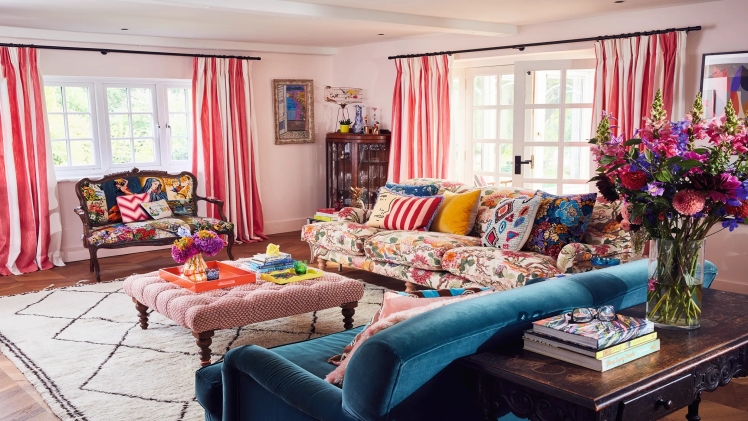Home decoration is an art form that allows individuals to express their personality, creativity, and style through the design and arrangement of their living spaces. One key element in achieving a well-designed and visually appealing interior is the skillful combination of patterns and textures. When done correctly, mixing patterns and textures can breathe life into a room, creating a harmonious and captivating ambiance. In this article, we will explore the art of mixing patterns and textures in home décor, offering tips and inspiration to help you elevate your interior design game.
Understanding Patterns and Textures
Before delving into the art of mixing patterns and textures, it’s essential to have a clear understanding of what these design elements entail.
Patterns: Patterns are visual motifs or designs that repeat in a predictable and organized manner. They can include geometric shapes, florals, stripes, polka dots, and many more. Patterns can be found in various forms, such as wallpapers, upholstery fabrics, area rugs, and decorative accessories. Incorporating patterns into your décor adds visual interest and can set the tone for the room.
Textures: Textures refer to the tactile qualities of surfaces in a space. These can encompass both the feel of materials and their visual appearance. Examples of textures include smooth, rough, glossy, matte, and everything in between. Texture can be introduced through materials like wood, leather, velvet, stone, and textiles. A careful selection of textures adds depth and dimension to your home décor.
The Benefits of Mixing Patterns and Textures
- Visual Interest: Mixing patterns and textures instantly makes a room more visually engaging. A space adorned with a variety of patterns and textures draws the eye and encourages exploration. It breaks up monotony and provides a feast for the senses.
- Personal Expression: Incorporating different patterns and textures allows you to infuse your personality into your living space. It reflects your unique style and preferences, making your home truly yours.
- Depth and Dimension: Textures, in particular, add depth to a room by creating contrast and tactile interest. Combining smooth and rough textures, for instance, can make a room feel more layered and inviting.
- Flexibility: Mixing patterns and textures offers flexibility in design. You can experiment with different combinations to create a look that suits your mood or a particular season.
- Enhanced Coziness: The presence of various textures and patterns can contribute to a sense of warmth and coziness. Soft fabrics and intricate designs create a welcoming atmosphere.
Tips for Mixing Patterns and Textures
While the benefits of mixing patterns and textures are clear, doing so successfully requires thoughtful planning and execution. Here are some essential tips to guide you in the process:
1. Start with a Neutral Base
Begin with a neutral color palette for your walls, floors, and larger pieces of furniture. Neutrals act as a blank canvas, allowing you to introduce patterns and textures without overwhelming the space. Colors like white, beige, gray, and soft pastels provide a versatile foundation.
2. Choose a Dominant Pattern
Select one dominant pattern that sets the tone for the room. This pattern will be the most prominent and should guide your choices for other patterns and textures. It could be a floral wallpaper, a striped area rug, or a bold geometric print on throw pillows.
3. Vary the Scale of Patterns
When mixing patterns, consider the scale of each design. Pair large-scale patterns with smaller ones to create balance and prevent visual chaos. For instance, if your dominant pattern is large and intricate, opt for smaller, more subtle patterns for accent pieces.
4. Stick to a Limited Color Palette
To maintain cohesiveness in your design, limit your color palette. Incorporate shades that complement your dominant pattern. This will tie the various elements together and create a harmonious look. A well-thought-out color scheme can also provide visual continuity.
5. Play with Textures
Experiment with a variety of textures to add depth and dimension to the room. For instance, combine smooth leather upholstery with plush, textured throw blankets, or pair sleek metal accents with rustic wooden furniture.
6. Mix Pattern Types
Mix different types of patterns to keep the design interesting. Combining geometric patterns with organic florals or stripes with abstract designs can create a dynamic and visually pleasing interior. Be sure to maintain a sense of cohesion through color and scale.
7. Create Balance
Achieving balance is crucial in mixing patterns and textures. Distribute patterns and textures throughout the room, ensuring there’s a visual equilibrium. Avoid clustering too many patterns or textures in one area, as this can be overwhelming.
8. Use Solids for Breathing Room
Incorporate solid-colored elements, such as throw pillows, curtains, or cushions, to break up patterns and provide visual relief. Solids can also act as connectors between different patterns, tying them together.
9. Mix Old and New
Blend vintage and modern elements in your décor to create an eclectic and inviting atmosphere. Older pieces often come with unique textures and patterns that can be seamlessly integrated into a contemporary design.
10. Trust Your Instincts
Ultimately, home décor is a personal endeavor. Trust your instincts and experiment with patterns and textures until you achieve a look that resonates with you. Don’t be afraid to make adjustments and evolve your design over time.
Inspiration for Mixing Patterns and Textures
To help you visualize the art of mixing patterns and textures in home décor, here are some inspirational ideas and examples:
- Bohemian Elegance: Combine rich, textured fabrics like Moroccan rugs, embroidered cushions, and tapestries with vibrant, intricate patterns. Layering textiles and incorporating warm, earthy colors will evoke a Bohemian feel.
- Coastal Chic: Create a coastal-inspired oasis by mixing nautical stripes, seashell motifs, and soft, beachy textures like jute rugs and airy linens. Add in elements of driftwood and light pastel hues to complete the look.
- Classic with a Twist: Blend classic patterns like herringbone, plaid, or damask with unexpected modern textures. For example, pair a traditional damask wallpaper with sleek, glossy furniture for a fresh take on timeless elegance.
- Maximalist Eclecticism: Embrace maximalism by layering bold patterns and rich textures throughout your space. Mix and match a diverse range of patterns, colors, and textures for an opulent and energetic interior.
- Minimalist Serenity: Even in a minimalist design, patterns and textures have a place. Stick to a limited color palette and incorporate subtle textures like matte ceramics, woven textiles, and geometric patterns for a clean yet inviting aesthetic.
- Rustic Comfort: Combine rugged, weathered textures like distressed wood and stone with cozy, traditional plaid patterns and warm, earthy colors. This creates a rustic, inviting atmosphere perfect for a cabin or country-style home.
- Modern Industrial: Infuse an industrial space with a touch of modernity by introducing clean, sleek textures like polished concrete and metal accents. Complement this with minimalist geometric patterns for a contemporary, urban look.
- Regal Opulence: For a luxurious ambiance, mix rich, opulent textures like velvet, silk, and gold accents with intricate, ornate patterns. This approach creates an environment fit for royalty.
- Artistic Fusion: Blend artistic patterns, such as abstract paintings or vibrant wall murals, with textural elements that complement the artistic theme. This approach transforms your living space into an ever-evolving gallery of creative expression.
- Nature-Inspired: Emulate the beauty of the natural world by incorporating botanical patterns, wood textures, and earthy colors. Create a harmonious, serene environment that brings the outdoors inside.
Conclusion
Mixing patterns and textures in home décor is a skill that, when mastered, can transform any space into a captivating and personalized haven. It’s an art that allows you to express your personality, creativity, and style while creating depth, visual interest, and balance in your home. Remember that successful pattern and texture mixing involves thoughtful planning, balance, and a willingness to trust your instincts. With the right guidance and inspiration, you can turn your living space into a stunning work of art that reflects your unique taste and personality. So go ahead, experiment, and let your creativity shine as you master the art of mixing patterns and textures in home décor.

